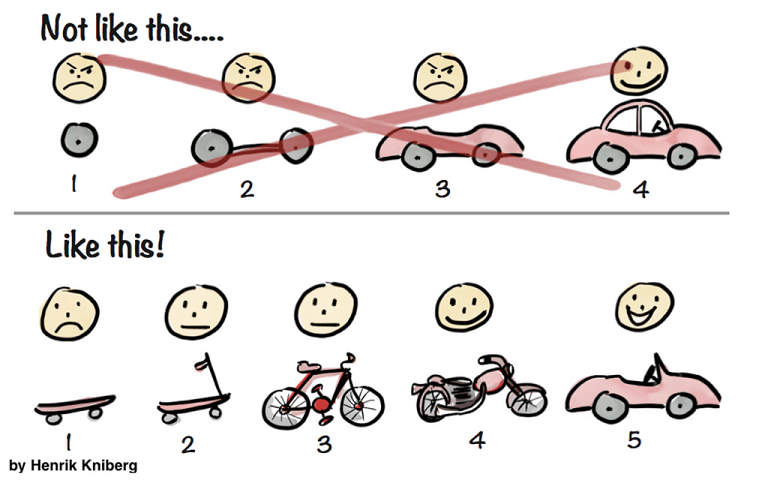
What is online marketplace? What is hot about it that makes many people go for it? What are the reasons behind? If you intend to build an online marketplace, what do you need to prepare and what are the challenges? These are the common questions asked by you, I, and those who are interested in marketplace model and want to build one.
Thanks to the technology advance, there’s hardly any limit to what people can do. Marketplace models aren’t new, instead, they have existed for decades. But with the latest technology, marketplace is brought online and quickly becomes a popular trend.
Amazon, eBay, Uber, AirBnB, Etsy are typical examples of online marketplaces. However, to build such a successful marketplace is not easy. It’s not an overnight success, but requires a thorough preparation, an effective business strategy and a lot of hard work. In this series, we want to share our knowledge and experience after years helping thousands of customers build up their marketplace businesses.
This series will cover topics about: Opportunities and challenges of building an online marketplace; Different kinds of platform and business models; Choosing the right business model; What you need to know when building a marketplace website with WordPress.
The first article will be about the booming of online marketplace, opportunities as well as challenges in this industry.
What is online marketplace?
Marketplaces aren’t new but have existed for decades. They are markets, bazaars, or shopping malls as we see today. These places have one thing common: all are 2-sided markets. What does it mean? 2 sides (or multiple sides) mean you need the participation of 2 or more different groups of customers for the marketplace to succeed. Let’s take shopping mall as an example. The shopping mall is divided into small kiosks to rent out to merchants. The shoppers then visit the mall and buy products and services from the merchants. It is clear to see that 2 sides here are merchants and shoppers. Merchants act as product/service producers while shoppers are consumers.

Things are the same in online marketplace. We need to get 2 sides of customers on board. The marketplace owner does not directly create inventory but acts as an intermediary connecting sellers and buyers.
Marketplace vs Online Store
To differentiate between marketplace and online store, there are some main points:
- Number of sellers: Online store has only 1 seller whereas there are multiple sellers on a marketplace.
- Revenue model: Online store owner, also the seller, earns money from the fixed price of each sale. Marketplace owner takes a percentage of sales whenever a transaction is made. There are also other revenue streams to be discussed in the following articles.
- Number of products/services: Usually, a marketplace has a wider range of products/services as there are more vendors in a marketplace than only 1 seller in an online store. As a result, buyers have a greater choice of products/services.
- Inventory: One of the greatest advantages of online marketplace is that it doesn’t hold any stock. Marketplace provides the platform connecting sellers and buyers, while the goods are stored by the buyers so the marketplace owner can avoid the burden of holding stocks. On the other hand, online store requires the seller to invest a quite big amount in creating and storing sufficient stocks. Fiverr is an online marketplace offering tasks and services. Freelancers will provide their services for those in need. Fiverr creates a great platform for service providers and consumers to meet each other, while the job of service delivery is performed and taken care of by sellers and buyers.
Online marketplaces are booming
The sharp rise of online marketplaces in recent years can somehow be explained by some advantages listed above. This business model is not limited to any industry but very scalable and can be applied in different sectors. Besides, technology solutions for online marketplace are getting more advanced. Together these things create the “just right” time for online marketplaces to explode.
Uber is a wonderful transportation app connecting people who have cars and those who are in need of a ride. AirBnB is a great short-term accommodation marketplace where people share their properties with those who are looking for a place to stay on holiday. Or Fiverr, another piece of the picture, is a service marketplace for lean entrepreneurs. It connects people in need of getting stuff done and freelancers who are willing to get it done at just $5. These 3 names come from different business areas, and all are doing a great job making people’s life easier and more convenient.
With so much potential to scale and the ability to solve society problems in different areas, the opportunities to enter this business model are huge. Many society problems remain unsolved so there are still a lot of space for the newcomers. However, the truth is building a successful online marketplace is not a trivial task. A lot of work and efforts are expected, and a sound strategy to solve challenges along the way.
Determine your motive and choose your niche
When embarking on anything, the most important thing is to be able to keep your passion throughout the journey. A strong will and passionate belief in what you do will help you overcome difficulties and achieve your goals. Determine your motive, ask yourself why you want to build an online marketplace, which problem you aim to solve. You’ve thought of an idea and are very passionate and determined about it, or you’ve figured out a problem that you can solve? Combining these two factors would create a feasible idea to start with. Solving a specific need of the society often means narrowing down to serve a group of people in a niche. The more specific your target customers, the better focus your solution has and the higher chance of success.

In fact, choosing a niche is the strategy you should take. It’s also called vertical marketplace as opposed to the horizontal. While horizontal marketplace tries to approach the whole audience, the vertical focuses on a segment and does its best to become the expert in that sector. So, figure out the untapped niche, build a great online marketplace for the audience in that niche.
Choose the ultimate technology solution
After determining the idea and the market niche, the next question is “How are you going to build your marketplace?” This part is mostly concerned with the technology software used to build up your online website and it is not less important than the idea itself. If you can write code yourself, it’s great. If not, you can hire developers to do it for you or buy software from well-known providers on the market. Building a good website is not simple. If you have some knowledge about web development, you will understand the essentials like User Experience, User Interface and Minimum Viable Product.
Minimum Viable Product (MVP)
Many may think “Oh I want to build a perfect marketplace from the beginning with full of features. But this might be a trap, causing you to fail at the very first stage. The first risk is that it would cost you a huge amount of capital and then the market response to your marketplace is not as what you expected. Second, the perfect definition here is just from your viewpoint, while customers, not you, are the ones that use your marketplace. So to know whether your marketplace meets users’ expectation, the best way is to launch it out and let your customers test it. Quora, for example, when its MVP was first launched, there was a feature that allowed users which the author role to reveal their profile (with detailed information like the one on LinkedIn), which had caused much controversy from the user community. As a result, Quora then had to remove this feature from their site. So it can be said that MVP is a necessary stage to test the real user experience.
Now the next question is “How many features are enough for the first launch?”, “Which features are needed first?”. To answer this, let’s talk about the Minimum Viable Product definition. MVP is a product which has just enough features to gather validated learning about the product and its continued development. A minimum viable product has the core features that allow the product to be deployed.

A minimum viable product is a usable product from version 1.0
In the very first phase building your marketplace, core features are needed to be built first to make a usable website. Just like the bottom half of the picture, the product is usable right from stage 1. Throughout the time, based on customer demands, you will build more features to upgrade your marketplace to be more convenient and effective.
User Experience (UX)
User Experience is responsible for creating the experience for your customers when interacting with your marketplace. And the job of making that experience great is utterly important. It’s not about how your website looks but how it works and how it makes your customers feel. The user flow should be smooth to make it easy for users to go back and forth. To do this, your UX designer needs to understand user behavior, the goals you want to reach to combine these two factors into an effective flow.
User Interface (UI)
While User Experience is the goal you want to achieve, User Interface is the means of getting there. UI is the visual look of your marketplace. It visualizes the steps users have to go through to attain the goal. Of course, UI is as necessary as UX since no one wants to stay on a site with an awful look.
Chicken and egg – The typical problem of online marketplaces
Which came first: the chicken or the egg? Who need to be brought to your site first: the buyers or the sellers? The chicken and the egg are dependent on each other as chickens hatch from eggs and chicken eggs are laid by chickens. Similarly, buyers and sellers cannot be separated, buyers just come to your marketplace when there are products/services available, and sellers only offer products/services on your site if there are buyers. So, the problem is not to argue which came first. It is about finding the way to solve chicken-and-egg problem. In other words, how to bring 2 sides of users on board at the same time.
One way to solve this problem lies in the pricing structure: the fee charged for each side. These fees need to be attractive enough to get both sides of users to your site. One possible strategy is to charge one side of user (sellers) while providing the other (buyers) with free services. For example, on a marketplace for second-hand computer software, the sellers list their items without having to pay any listing fee, and only takes a percentage as commission fee when an item is sold. On the buyer’s side, the marketplace is free. The buyers have free access to all items listed and can buy anything without paying any fee to the marketplace owner. Doing this way will encourage buyers’ participation, especially true at the entry phase of your marketplace. And when the marketplace obtains a critical mass of buyers, more sellers will get on board.
Some benefits of this pricing structure include:
- The marketplace can quickly get the participation from one key side of the market – the buyers by providing free services.
- The fee charged is also reasonable for the sellers. They pay no listing fee and just lose a portion of the sales price as commission when an actual transaction takes place.
- Both buyers and sellers have someone organize a “bazaar” for them. Sellers don’t need to create a place to list their items, whereas the buyers can instantly search for what they need in a place. By bringing 2 sides to a place, buyers and sellers have greater match prospects.
Besides commission fee, there are other business models that can be applied for your marketplace. The details will be discussed further in the next posts.
Another way to solve chicken-and-egg problem is to act as a provider. At the entry phase, when there are not many providers on site, the marketplace can solve the problem by supplying its own chicken. The marketplace owners will also be the product/service providers, at least initially.
The third tactic is to subsidize one side of the market. To attract product/service providers, vocational training, free equipments to create the products or services, and even marketing service are provided. Let’s take AirBnB as an example. At first, it seemed complicated and required a lot of effort for potential renters to create an attractive listing. AirBnB decided to write the listing description on their behalf and hire professional photographers to take awesome pictures of apartments for such potential renters. Other marketing activities are boosted on social media, email to actively promote these apartments to potential customers. By offering many benefits, the marketplace can manage to encourage the participation from benefited group. As a result of network effect, this will attract the other side to the marketplace.
Summary
Marketplace platform is a 2-sided market which needs the participation of 2 or multiple groups of customers to achieve success. This business model is a great idea for entrepreneurs who want to create an online place connecting providers and consumers. With many differences from online store, marketplace has its own opportunities as well as challenges. The most typical challenge is the chicken-and-egg problem: how to get 2 sides of users on board. To solve this problem, it’s important to determine a reasonable pricing structure for both 2 sides. Besides, the marketplace can provide its own chicken by acting as a provider to attract consumers and other providers. Another way is to invest on one side to help them get used to your marketplace and make it easier for them to join.
The next article will be about business model definition and the list of different models on the market.


